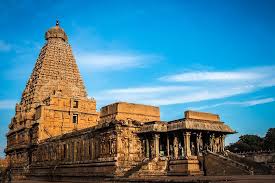The Brihadeeswarar Temple, also commonly known as Peruvudaiyar Kovil, is located in Thanjavur, Tamil Nadu, and is dedicated to Lord Shiva. Crafted by the Chola dynasty, it’s one of the Great Living Chola Temples, named a UNESCO World Heritage Site. Over a thousand years old, this temple is known for its towering presence, intricate stonework, and sacred meaning. Spanning about 10 acres, it pulls in people who worship, study history, or just want to see something remarkable.
History of Brihadeeswarar Temple
The Brihadeeswarar Temple was commissioned by King Rajaraja Chola I, who ruled from 985 to 1014 CE. He kicked off the building in 1003 CE, and by 1010 CE, it was done—seven years, start to finish, as the temple’s stone carvings tell us. It was finished by 1010 CE, as carved writings on the temple’s stones tell us. Rajaraja, a devoted worshipper of Shiva, dreamed of a temple that would show his kingdom’s power, faith, and love for art. Named for Shiva as Brihadeeswarar, or “Great Lord,” the temple was not just a place of prayer but a hub for culture and governance.
Old carvings share details of the temple’s wealth. Rajaraja gave land, gold, and animals to keep it running, and he appointed hundreds of priests, dancers, and workers to care for it. Entire villages were dedicated to providing rice, oil, and other supplies, making the temple a center of local life. The Cholas used their skill to build with huge granite stones—some as heavy as 80 tons—hauled from far-off quarries. Finishing such a massive project in just seven years shows their riches and planning.
When Rajaraja died, his son Rajendra Chola I, ruling from 1012 to 1044 CE, kept the temple strong. Other Chola kings, like Kulothunga I, looked after it too, as more carvings prove. The temple’s fame spread, catching the ears of poets and holy folks like the Nayanar saints, who sang about Shiva’s power.
By the 1500s, the Vijayanagara Empire and Nayak rulers took over, adding bits here and there and keeping the old ways alive. In the 1600s, the Marathas, with leaders like Serfoji II, stepped in, fixing things up and holding onto traditions, as their own carvings show.
The 1700s were a messy time. In 1757, the French grabbed Thanjavur, but they didn’t stay long. The British took over in 1760, another set of outsiders calling the shots. Then, in 1790, Tippu Sultan swept in, adding the area to his lands. South India was like that back then—rulers coming and going, power shifting fast. Through it all, the temple stood firm, a steady place for prayer.
By 1855, the British had settled in, handling the temple’s needs. After India broke free, the Tamil Nadu government’s Hindu Religious and Charitable Endowments Board—HR&CE for short—took charge in 1951, and they’re still at it. In 1987, UNESCO called the temple a World Heritage Site, saying it matters to history and culture. All those changes, and the temple’s still here, carrying the Cholas’ spirit.
The temple’s holy side runs deep too. Back in the 7th century, Nayanar saints Appar, Sambandar, and Sundarar wrote songs for it in their Tevaram collection, making it a Paadal Petra Sthalam, a Shiva shrine people hold dear. Those songs, and later works like Sekkizhar’s Periyapuranam about the saints, gave the temple a sacred spark. It still moves people today.
Architecture of the Temple
The Brihadeeswarar Temple is a stunner, built in the Dravidian way with a tower that grabs your eye and stones carved like stories. It covers 10 acres, with a big wall around it and a moat on two sides. The main piece is the vimana, a 216-foot tower with 13 levels over the shrine, all granite. It’s one of the tallest temple towers anywhere, topped by a single 80-ton stone the Cholas somehow got up there—a real head-scratcher.
Inside, there’s a Shiva Lingam, over 12 feet tall, standing for Brihadeeswarar. The walls outside are covered in carvings—gods, dancers, creatures from old tales, each one done with care. Most Dravidian temples have a big entrance gopuram, but here it’s smaller than the vimana, letting the shrine take center stage.
The grounds have halls, called mandapas, with pillars cut in fine shapes. Near the front, a huge Nandi—Shiva’s bull—sits, 16 feet long, carved from one stone and weighing 25 tons. Other shrines for Parvati, Ganesha, Murugan, and more are scattered around. A 96-foot wall painting, found in the 1930s, shows Shiva’s cosmic dance and bits of Chola life, like a glimpse into their world.
Legend of the Temple
According to a legend, King Rajaraja Chola I got a divine vision when he sought to build a grand monument to honor the deity and showcase his empire’s prosperity. One night, as the legend goes, Shiva appeared to Rajaraja in a dream, seated as a towering figure radiating light. The king was instructed by Lord Shiva to build a temple in Thanjavur, where a huge Shiva Lingam would represent his cosmic presence. Shiva commanded that the temple’s vimana, or tower, should reach the sky, signifying his omnipotence, and that it would serve as a beacon of devotion for all eternity.
Rajaraja selected Thanjavur, the capital of the Chola, as the location after being guided by this vision. According to the narrative, heavenly signs indicated the precise location: a lingam was found buried in the ground, thought to be self-manifested, and a sacred bull (Nandi) was spotted sitting on the spot where the temple’s sanctum presently sits. Rajaraja promised to construct a temple unlike any other once these omens validated the site’s holiness.
Festivals and Rituals
The temple lights up for festivals, especially Maha Shivaratri, when crowds pray and sing all night. The Brahmotsavam, a 10-day event, has parades, music, and dance. Other days, like Navaratri and Arudra Darshan, celebrate Shiva’s cosmic dance. Five times a day, priests do rituals—morning chants, evening offerings—keeping the temple’s spirit alive.
Cultural and Modern Importance
The Brihadeeswarar Temple showcases the Tamil culture, its stones and paintings telling Chola stories. Festivals along with classical music and dance, and poets like Ottakoothar got their spark here. Now, it draws people from everywhere, with Thanjavur 350 km from Chennai by road or train, easy enough to reach.
Conclusion
The Brihadeeswarar Temple is a living reality of Tamil Nadu’s heritage. From a Chola king’s big idea to a world treasure, it carries centuries of faith and craft. Its tall vimana, sacred Lingam, and lively festivals make it special. The temple offers a direct connection to India’s profound cultural and religious traditions and Lord Shiva’s cosmic presence.











